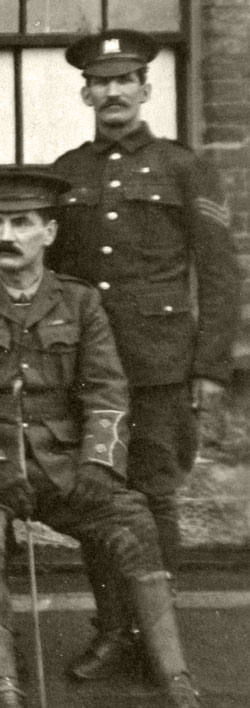Sergeant William McIlroy

William McIlroy was born on 27 April 1876 at Altnavannog, Dungannon, County Tyrone, the second of twelve children of coachman (also labourer and car driver) William McIlroy and his wife Sarah (née McMeehan or McMeekin). Soon after, the family moved to Armagh.
On 25 January 1895 at Armagh, William enlisted in the Royal Irish Rifles (No.4528). At the time he was serving in the 3rd Battalion, Royal Irish Fusiliers, a militia unit, and working as a labourer. His older brother, Robert John, was already serving in the Royal Irish Rifles. Posted to the 2nd Battalion, William embarked for India on 8 October 1896, returning to the UK on 16 February 1899. Later that year, on 25 October, he embarked for South Africa, where he took part in the Boer War. He returned to the UK on 20 December 1902, where he was transferred to the Army Reserve. He was discharged on the termination of his 12 years' engagement on 24 January 1907.
In 1904 McIlroy was living in Belfast and working as a carter. On 4 April that year he married Letitia Martin in St Thomas's Church of Ireland Parish Church in Belfast. The couple had two children, though the second lived for only six days. At the time of the 1911 Census they were living at 5 Wellwood Street, Belfast, William working as a carter. Soon after, they moved to 119 Agincourt Avenue.
McIlroy enlisted in the 6th (Inniskilling) Dragoons Service Squadron at Belfast on 23 October 1914 (No. UD/87 – later Corps of Dragoons No.21235). Three days later he was promoted to the rank of sergeant. On 6 October 1915 he embarked for France with his squadron, which was then serving as divisional cavalry to the 36th (Ulster) Division.
In June 1916 the Inniskilling squadron joined with C and F Squadrons of the North Irish Horse to form the 2nd North Irish Horse Regiment, serving as corps cavalry to X Corps.
On 5 July the regimental diary described an artillery barrage faced by two troops of the squadron in Aveluy Wood during the Battle of the Somme, noting Sergeant McIlroy's involvement:
Orders were received from A.P.M. 36th Division at 9 am for the two troops dismounted to report to Capt O'Neill at Lancashire Dump for salvage duty. They carried out this duty bringing in equipment, rifles etc till 1 pm. The men had dinner and were just turning out again when Lieut Seymour received orders from 36th Division to return to Regtl Head Quarters. The men had just started to saddle up when a heavy bombardment of both high explosive, shrapnel & machine guns was concentrated on the Wood. The intensity of the fire necessitated Lt Seymour giving orders for the men to take shelter in some old dugouts & trenches close by. The bombardment lasted for 3/4 of an hour & then slackened but did not entirely stop. Up to now one horse was killed & four wounded. The men were then ordered to saddle up & lead their horses thro' Wood out on to the road and were waiting for the others to join up when the bombardment opened much heavier than previously especially on that part of the road where the men were waiting. Lt Seymour moved off up the road leaving 2/Lt Matthews & Sergt McIlvoy to round up the stragglers in the wood, as by this time horses were very restive and almost unmanagable. Lt Seymour with his party had reached about 1 mile along the road & turned down a lane leaving the horses in charge of Sergt Quinn. Almost immediately a heavy fire was brought to bear on the horses and Sergt Quinn was wounded. The horses stampeded in every direction, some back to Aveluy Wood. Eventually Lt Seymour was able to round up most of this party & got to Senlis. Lieut Matthews & Sergt McIlroy remained behind. Our losses numbered 16 horses killed or wounded and 2 missing. 2/Lt Matthews was wounded severely in the knee from high explosive and Pte Downes, Nicholl, Gourley wounded (hosp) and Ptes Buchanan, 195 Campbell, Totton, 105 Craig, Cpl Dickson, 209 Robinson slightly wounded (duty).
In August-September 1917 the 2nd NIH Regiment was disbanded and its men were transferred to the Royal Irish Fusiliers, an infantry regiment. Sergeant McIlroy, however, was not among them. He may have been found not physically fit for infantry service, given his age. On 20 October he left France for the UK, returning to duty at the Service Squadron reserve at Enniskillen.
McIlroy was demobilised and transferred to Class Z, Army Reserve, on 4 March 1919. His military character was recorded as 'very good'. He was awarded a pension due to 'gastritis', which was found to have been aggravated by his military service. On 24 June 1920 he was granted £50 for a drapery business.
Following his demobilisation McIlroy returned to 119 Agincourt Avenue and worked as a 'checker'. His wife Letitia died on 15 March 1923. Mcilroy died on 14 February 1946 and was buried in the Dundonald Cemetery.
The image of Sergeant McIlroy is part of a group photo of officers and NCOs of the squadron which appeared in the Belfast Evening Telegraph of 28 January 1915. The full image can be seen here.
This page last updated 23 February 2023.
